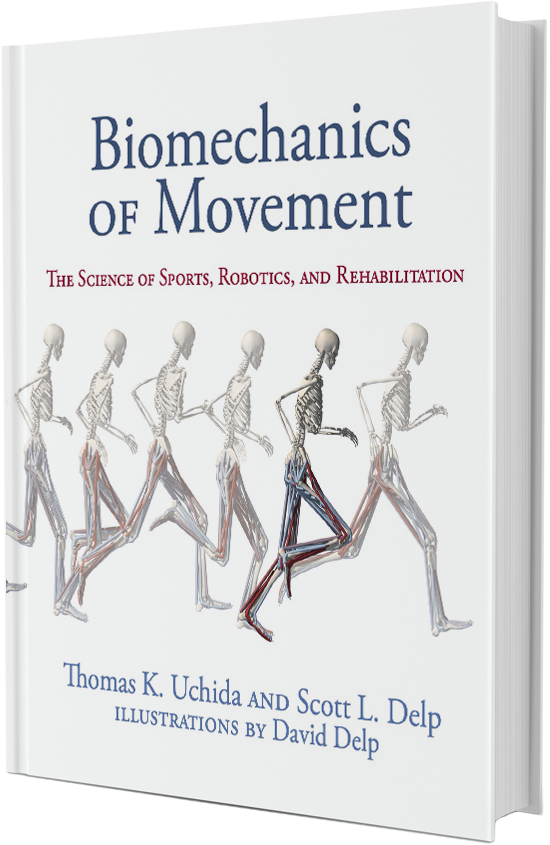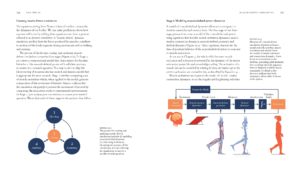Welcome to the official website for
Biomechanics of Movement
The Science of Sports, Robotics, and Rehabilitation
by Thomas K. Uchida and Scott L. Delp
Illustrations by David Delp
Here you will find resources to deepen your knowledge of biomechanics and connect you with the vibrant communities and technologies that are redefining the field.

Published by MIT Press
Access homework & lectures to expand your understanding of concepts introduced in the book.
Download models and data to design your own biomechanics experiments.
Use OpenSim software to reproduce the simulations described in the book.
Join our educators' community and gain access to exams, class project ideas, and other materials to teach biomechanics.
Highlight your research and ideas and contribute to our growing community library of videos, problem sets, demos, and data.
Preview the book through its table of contents, illustrations, page spreads, and more.
Homework & lectures
Our "Biomechanics of Movement Classroom" is a dynamic community-driven resource for you to expand your understanding of biomechanics. Access a growing collection of homework problems for each book chapter and learn from the rich lecture slides and videos created by university professors.
Data & models
Data underpins the concepts presented in the book. We have made this data available for you to explore these concepts and launch new biomechanical studies:
- Experimental data
- Models derived from experimental data
- Simulation results
Gain access through SimTK.org, a free project-hosting platform for the scientific community.

OpenSim software
Most of the simulations in the book were created in OpenSim, open-source, state-of-the-art simulation software for musculoskeletal modeling and dynamic simulation. Cited by over 3000 scientific articles, OpenSim is being used to address fundamental questions in movement science and advance our understanding in clinical areas such as stroke, spinal cord injury, and osteoarthritis. Learn more
Download the software at SimTK.org.
Find examples and tutorials along with all OpenSim documentation.

Educators' community
Whether you are looking for one example to include in a lecture on muscle biology or teaching an entire semester on biomechanics, we provide free resources and the opportunity to collaborate with other educators to make biomechanics engaging for your students.
When you partner with us, you will get access to:
- Editable lecture slides from experts around the world
- Test problems
- Curriculum for teaching diverse audiences
- Class project ideas
Contribute your work
We'd love your contributions and feedback.
Do you have a great homework problem to share? Or data from your own research, simulation examples, or OpenSim tutorials?
How about a neat video?
Contribute to the growing community of students, teachers, and researchers.
More about the book

Just as human movement turns complexity into seemingly effortless elegance, Uchida and Delp distill the intricate, interdisciplinary world of biomechanics into a foundational text. Approachable, illustrative, and inspiring, this book will have you making leaps and bounds into biomechanics.
— Helena Scutt, Olympian & Mechanical Engineer
An engaging introduction to human and animal movement seen through the lens of mechanics.
How do Olympic sprinters run so fast? Why do astronauts adopt a bounding gait on the moon? How do running shoes improve performance while preventing injuries? This engaging and generously illustrated book answers these questions by examining human and animal movement through the lens of mechanics.
The authors present simple conceptual models to study walking and running and apply mechanical principles to a range of interesting examples. They explore the biology of how movement is produced, examining the structure of a muscle down to its microscopic force-generating motors. Drawing on their deep expertise, the authors describe how to create physics-based simulations that provide insight into muscle coordination during walking and running, suggest treatments to improve function following injury, and help design devices that enhance human performance.
Take a look inside
View the table of contents and the first chapter of the book, along with sample pages from several other chapters.
The book emphasizes principles that provide a foundation for understanding movement. It also describes recent innovations in computer simulation, mobile motion monitoring, wearable robotics, and other technologies that build on these fundamentals. The book is suitable for use as a textbook by students and researchers studying human and animal movement. It is equally valuable for clinicians, roboticists, engineers, sports scientists, designers, computer scientists, and others who want to understand the biomechanics of movement.
A beautifully-illustrated, cogent, and comprehensive treatment of biomechanics for legged locomotion, with a dash of physics, computer simulation, and robotics stirred in for good measure. It is written in the language of engineering, making it accessible to biologists, scientists, and engineers alike.
—Marc Raibert, Founder, Boston Dynamics
The authors
Thomas K. Uchida is an Assistant Professor in the Department of Mechanical Engineering at the University of Ottawa. Scott L. Delp is the James H. Clark Professor of Bioengineering, Mechanical Engineering, and Orthopedic Surgery at Stanford University. David Delp is a user experience designer, graphic designer, and illustrator in San Francisco.
Delp and Uchida have created a masterpiece of biomechanical integration! This textbook provides a deep but accessible view of movement while explaining underlying physiological and engineering principles. Their writing style is relaxed but rigorous and the illustrations delightfully engaging.
—Richard L. Lieber, Chief Scientific Officer and Senior Vice President, Shirley Ryan Ability Lab

Learn more about Biomechanics of Movement and ...
Biomechanics of Movement
The Science of Sports, Robotics, and Rehabilitation
by Thomas K. Uchida and Scott L. Delp
Illustrations by David Delp
Here you will find resources to deepen your knowledge of biomechanics and connect you with the vibrant communities and technologies that are redefining the field.

Published by MIT Press










































